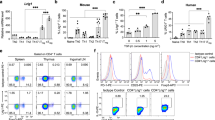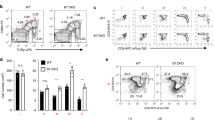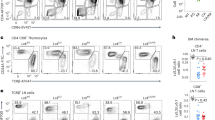Abstract
Signaling through the G protein–coupled receptors for the complement fragments C3a and C5a (C3aR and C5aR, respectively) by dendritic cells and CD4+ cells provides costimulatory and survival signals to effector T cells. Here we found that when signals from C3aR and C5aR were not transduced into CD4+ cells, signaling via the kinases PI(3)Kγ, Akt and mTOR ceased, activation of the kinase PKA increased, autoinductive signaling by transforming growth factor-β1 (TGF-β1) initiated and CD4+ T cells became Foxp3+ induced regulatory T cells (iTreg cells). Endogenous TGF-β1 suppressed signaling through C3aR and C5aR by preventing the production of C3a and C5a and upregulating C5L2, an alternative receptor for C5a. The absence of signaling via C3aR and C5aR resulted in lower expression of costimulatory molecules and interleukin 6 (IL-6) and more production of IL-10. The resulting iTreg cells exerted robust suppression, had enhanced stability and suppressed ongoing autoimmune disease. Antagonism of C3aR and C5aR can also induce functional human iTreg cells.
This is a preview of subscription content, access via your institution
Access options
Subscribe to this journal
Receive 12 print issues and online access
$209.00 per year
only $17.42 per issue
Buy this article
- Purchase on SpringerLink
- Instant access to full article PDF
Prices may be subject to local taxes which are calculated during checkout







Similar content being viewed by others
References
Wing, K. & Sakaguchi, S. Regulatory T cells exert checks and balances on self tolerance and autoimmunity. Nat. Immunol. 11, 7–13 (2010).
Josefowicz, S.Z. et al. Extrathymically generated regulatory T cells control mucosal TH2 inflammation. Nature 482, 395–399 (2012).
Shevach, E.M. Mechanisms of foxp3+ T regulatory cell-mediated suppression. Immunity 30, 636–645 (2009).
Josefowicz, S.Z. & Rudensky, A. Control of regulatory T cell lineage commitment and maintenance. Immunity 30, 616–625 (2009).
Strainic, M.G. et al. Locally produced complement fragments C5a and C3a provide both costimulatory and survival signals to naive CD4+ T cells. Immunity 28, 425–435 (2008).
Lalli, P.N. et al. Locally produced C5a binds to T cell-expressed C5aR to enhance effector T-cell expansion by limiting antigen-induced apoptosis. Blood 112, 1759–1766 (2008).
Liu, J. et al. IFN-γ and IL-17 production in experimental autoimmune encephalomyelitis depends on local APC-T cell complement production. J. Immunol. 180, 5882–5889 (2008).
Weaver, D.J. Jr. et al. C5a receptor-deficient dendritic cells promote induction of Treg and TH17 cells. Eur. J. Immunol. 40, 710–721 (2010).
Hashimoto, M. et al. Complement drives TH17 cell differentiation and triggers autoimmune arthritis. J. Exp. Med. 207, 1135–1143 (2010).
Shevach, E.M. et al. The lifestyle of naturally occurring CD4+ CD25+ Foxp3+ regulatory T cells. Immunol. Rev. 212, 60–73 (2006).
Wei, J. et al. Antagonistic nature of T helper 1/2 developmental programs in opposing peripheral induction of Foxp3+ regulatory T cells. Proc. Natl. Acad. Sci. USA 104, 18169–18174 (2007).
Itoh, S. et al. Interleukin-17 accelerates allograft rejection by suppressing regulatory T cell expansion. Circulation 124, S187–S196 (2011).
Paul, W.E. & Zhu, J. How are TH2-type immune responses initiated and amplified? Nat. Rev. Immunol. 10, 225–235 (2010).
Laouar, Y. et al. TGF-β signaling in dendritic cells is a prerequisite for the control of autoimmune encephalomyelitis. Proc. Natl. Acad. Sci. USA 105, 10865–10870 (2008).
Chi, H. Regulation and function of mTOR signalling in T cell fate decisions. Nat. Rev. Immunol. 12, 325–338 (2012).
Schraufstatter, I.U., Trieu, K., Sikora, L., Sriramarao, P. & DiScipio, R. Complement c3a and c5a induce different signal transduction cascades in endothelial cells. J. Immunol. 169, 2102–2110 (2002).
Alcázar, I. et al. Phosphoinositide 3-kinase γ participates in T cell receptor-induced T cell activation. J. Exp. Med. 204, 2977–2987 (2007).
Huang, J. & Manning, B.D. A complex interplay between Akt, TSC2 and the two mTOR complexes. Biochem. Soc. Trans. 37, 217–222 (2009).
Ching, C.B. & Hansel, D.E. Expanding therapeutic targets in bladder cancer: the PI3K/Akt/mTOR pathway. Lab. Invest. 90, 1406–1414 (2010).
Sauer, S. et al. T cell receptor signaling controls Foxp3 expression via PI3K, Akt, and mTOR. Proc. Natl. Acad. Sci. USA 105, 7797–7802 (2008).
Yaqub, S. & Tasken, K. Role for the cAMP-protein kinase A signaling pathway in suppression of antitumor immune responses by regulatory T cells. Crit. Rev. Oncog. 14, 57–77 (2008).
Merkenschlager, M. & von Boehmer, H. PI3 kinase signalling blocks Foxp3 expression by sequestering Foxo factors. J. Exp. Med. 207, 1347–1350 (2010).
Zhang, M., Fraser, D. & Phillips, A. ERK, p38, and Smad signaling pathways differentially regulate transforming growth factor-β1 autoinduction in proximal tubular epithelial cells. Am. J. Pathol. 169, 1282–1293 (2006).
Flanders, K.C., Holder, M.G. & Winokur, T.S. Autoinduction of mRNA and protein expression for transforming growth factor-beta S in cultured cardiac cells. J. Mol. Cell. Cardiol. 27, 805–812 (1995).
Kim, S.J., Jeang, K.T., Glick, A.B., Sporn, M.B. & Roberts, A.B. Promoter sequences of the human transforming growth factor-β1 gene responsive to transforming growth factor-β1 autoinduction. J. Biol. Chem. 264, 7041–7045 (1989).
Bamberg, C.E. et al. The C5a receptor (C5aR) C5L2 is a modulator of C5aR-mediated signal transduction. J. Biol. Chem. 285, 7633–7644 (2010).
Gao, H. et al. Evidence for a functional role of the second C5a receptor C5L2. FASEB J. 19, 1003–1005 (2005).
Cain, S.A. & Monk, P.N. The orphan receptor C5L2 has high affinity binding sites for complement fragments C5a and C5a des-Arg(74). J. Biol. Chem. 277, 7165–7169 (2002).
Okinaga, S. et al. C5L2, a nonsignaling C5A binding protein. Biochemistry 42, 9406–9415 (2003).
Chen, Q., Kim, Y.C., Laurence, A., Punkosdy, G.A. & Shevach, E.M. IL-2 controls the stability of Foxp3 expression in TGF-β-induced Foxp3+ T cells in vivo. J. Immunol. 186, 6329–6337 (2011).
Haribhai, D. et al. A requisite role for induced regulatory T cells in tolerance based on expanding antigen receptor diversity. Immunity 35, 109–122 (2011).
Pothoven, K.L. et al. Rapamycin-conditioned donor dendritic cells differentiate CD4CD25Foxp3 T cells in vitro with TGF-β1 for islet transplantation. Am. J. Transplant. 10, 1774–1784 (2010).
Tran, D.Q., Ramsey, H. & Shevach, E.M. Induction of FOXP3 expression in naive human CD4+FOXP3 T cells by T-cell receptor stimulation is transforming growth factor-β dependent but does not confer a regulatory phenotype. Blood 110, 2983–2990 (2007).
Allan, S.E. et al. Activation-induced FOXP3 in human T effector cells does not suppress proliferation or cytokine production. Int. Immunol. 19, 345–354 (2007).
Wang, J., Ioan-Facsinay, A., van der Voort, E.I., Huizinga, T.W. & Toes, R.E. Transient expression of FOXP3 in human activated nonregulatory CD4+ T cells. Eur. J. Immunol. 37, 129–138 (2007).
Gavin, M.A. et al. Single-cell analysis of normal and FOXP3-mutant human T cells: FOXP3 expression without regulatory T cell development. Proc. Natl. Acad. Sci. USA 103, 6659–6664 (2006).
Bettelli, E. et al. Reciprocal developmental pathways for the generation of pathogenic effector TH17 and regulatory T cells. Nature 441, 235–238 (2006).
O'Gorman, W.E. et al. The initial phase of an immune response functions to activate regulatory T cells. J. Immunol. 183, 332–339 (2009).
Ohno, M. et al. A putative chemoattractant receptor, C5L2, is expressed in granulocyte and immature dendritic cells, but not in mature dendritic cells. Mol. Immunol. 37, 407–412 (2000).
Honczarenko, M. et al. C5L2 receptor is not involved in C3a/C3a-desArg-mediated enhancement of bone marrow hematopoietic cell migration to CXCL12. Leukemia 19, 1682–1683, author reply 1684–1685 (2005).
Lee, H., Whitfeld, P.L. & Mackay, C.R. Receptors for complement C5a. The importance of C5aR and the enigmatic role of C5L2. Immunol. Cell Biol. 86, 153–160 (2008).
Chen, N.J. et al. C5L2 is critical for the biological activities of the anaphylatoxins C5a and C3a. Nature 446, 203–207 (2007).
Gerard, N.P. et al. An anti-inflammatory function for the complement anaphylatoxin C5a-binding protein, C5L2. J. Biol. Chem. 280, 39677–39680 (2005).
Rittirsch, D. et al. Functional roles for C5a receptors in sepsis. Nat. Med. 14, 551–557 (2008).
Fang, C., Zhang, X., Miwa, T. & Song, W.C. Complement promotes the development of inflammatory T-helper 17 cells through synergistic interaction with Toll-like receptor signaling and interleukin-6 production. Blood 114, 1005–1015 (2009).
Hajishengallis, G. & Lambris, J.D. Crosstalk pathways between Toll-like receptors and the complement system. Trends Immunol. 31, 154–163 (2010).
Hawlisch, H. & Kohl, J. Complement and Toll-like receptors: key regulators of adaptive immune responses. Mol. Immunol. 43, 13–21 (2006).
Zhang, X. et al. Regulation of Toll-like receptor-mediated inflammatory response by complement in vivo. Blood 110, 228–236 (2007).
Heeger, P.S. et al. Decay-accelerating factor modulates induction of T cell immunity. J. Exp. Med. 201, 1523–1530 (2005).
Acknowledgements
We thank J. Lambris (University of Pennsylvania) for C5aR-A synthetic peptide; C. Gerard (Harvard University) for C3ar1−/−, C3ar1−/− and Gpr77−/− mice; V.J. Kuchroo (Harvard University) for Foxp3-GFP mice; Michael Caroll (Harvard University) for C3−/− mice; B. Cobb, S.v.n. Prasad, G. Dubyak and D. Anthony Jr. for critical reading; M. Sramkoski for help with six-color flow cytometry in vivo suppression assays; H.S. Kim for immunoblot analysis; J. Letterio (Case Western Reserve University) for the inhibitor of TGF-βR1, mAb to TGF-β1 and inhibitor of Smad3 and for discussions; and P. Heeger for discussions. Supported by the US National Institutes of Health (R0123598 and EY011288 to M.E.M.; T32 HL083823-03 to M.G.S.; and AI071125 to P. Heeger) and the US Department of Defense (BC085077 to M.E.M.).
Author information
Authors and Affiliations
Contributions
M.G.S. did and analyzed the experiments and participated in their design and the writing of the manuscript; E.M.S. consulted in the design and analysis of the experiments and participated in the writing of the manuscript; F.A. did some of the experiments and prepared the knockout mice; F.L. consulted in the design and analysis of the experiments; the M.E.M. group developed original concepts and brought them to E.M.S.; all work was done in the laboratory of M.E.M. under the direction of M.E.M.; and M.E.M. designed and analyzed the experiments and wrote the manuscript.
Corresponding author
Ethics declarations
Competing interests
The authors declare no competing financial interests.
Supplementary information
Supplementary Text and Figures
Supplementary Figures 1–8 (PDF 5368 kb)
Rights and permissions
About this article
Cite this article
Strainic, M., Shevach, E., An, F. et al. Absence of signaling into CD4+ cells via C3aR and C5aR enables autoinductive TGF-β1 signaling and induction of Foxp3+ regulatory T cells. Nat Immunol 14, 162–171 (2013). https://doi.org/10.1038/ni.2499
Received:
Accepted:
Published:
Issue Date:
DOI: https://doi.org/10.1038/ni.2499



